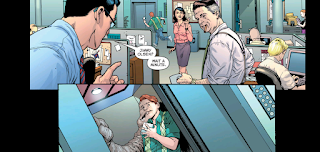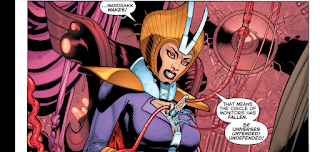FINAL CRISIS
Final Crisis #1-7, Final Crisis: Superman Beyond #1-2, Final Crisis: Submit #1, Batman #682-683
Originally released in 2008
Written by Grant Morrison
Art by J.G. Jones (Final Crisis #1-6), Doug Mahnke (Final Crisis #7, Superman Beyond), Matthew Clark (Submit), and Lee Garbett (Batman)
Darkseid is dying, and he's taking the multiverse with him. I'm a little concerned about reading through this now (for all I know, Grant Morrison's run on Animal Man is going to be crucial to understanding this), but I intend to read the Morrison-written tie-ins, which should hopefully help.
The story starts in a way that's reminiscent of 2001: A Space Odyssey, with Metron arriving on prehistoric Earth to give humanity the gift of fire. This doesn't seem relevant to the story, though it helps to establish its epic scope.
In the modern day, Detective Dan Turpin discovers the corpse of Orion, one of the New Gods. This leads to Earth being cordoned off by the Alpha Lanterns (high-ranking Green Lanterns who come across as being particularly smug and arrogant here to the point where they seem to see themselves as being above the New Gods) as they investigate.
Turpin made some appearances in Kirby's New Gods series, though here, he quickly finds himself possessed by Darkseid while investigating some missing children. Darkseid is burning through bodies quickly, which decay as they struggle to contain his power and corruption, but as established in Seven Soldiers of Victory, he has found the Anti-Life Equation - he just needs the right moment to use it.
Metron's gift of fire is a great boon to humanity, but it can also be incredibly dangerous. Libra demonstrates this in his bid to take over the Secret Society, having Martian Manhunter tranquilized and kidnapped on behalf of the Human Flame. The Human Flame is a Z-lister, so pathetic that he doesn't even take part in his own revenge scheme. Instead, three other super-villains light Martian Manhunter on fire, killing him as the Human Flame records the whole thing on his phone and says things like "that's what happens when you mess with the Human Flame!" (despite, once again, doing absolutely nothing beyond watching) It seems to speak volumes about Martian Manhunter's rogues gallery that this guy is the representative of it.
It's a shame that Martian Manhunter was killed so abruptly. I'm not sure why it was done; given how events that happen later take out most worldwide communications systems, maybe it was to prevent the heroes from being able to get in contact with each other. It could have been to establish Libra as a threat, I suppose - it wouldn't have made as much of an impact if Libra had killed Adam Strange, Peacemaker, or Doctor Thirteen. (a man whose life's mission is to debunk the supernatural, despite living in the DC universe)
However, Libra is just a harbinger of a much bigger problem, as he serves Darkseid. As Hal Jordan is framed for Orion's murder and taken off-world, and the Justice League members are reeling from J'onn's death and investigating Orion's murder, the Secret Society launches further attacks, such as planting a bomb at the Daily Planet.
With Lois badly wounded and near death, Superman has to help one of the Monitors in order to get what he needs to save her. The Monitor was established in the lead-up to Crisis on Infinite Earths, and I believe that it was later determined that there were many Monitors, one for each universe. Morrison reimagines them here as beings that exist outside of the universe, observing it.
When Crisis on Infinite Earths brought them into the story, they became tied up in narrative conventions, gaining personalities, conflict, and other aspects that they really don't want to have. They serve as stand-ins for the audience, in a sense, and are trying to keep an ancient and terrible being sealed away - Mandrakk, the Dark Monitor.
I'm not sure why Mandrakk exists; his role as the evil equivalent of the Monitors already seems to be filled by the Anti-Monitor. Maybe Morrison thought that bringing back the Anti-Monitor would be too repetitive and they wanted to go in a different direction.
However, Final Crisis is willing to call back to Crisis on Infinite Earths - while Wally West and Jay Garrick are investigating the source of the radion bullet that killed Orion (radion basically serving as Kryptonite for the New Gods), they encounter a familiar face - Barry Allen, running from the Black Racer and chasing the bullet that killed Orion back in time.
Also, the Monitors are vampires. I'm not sure if this was established in some appearance of the Monitors that I missed, or if it's a sign of how Darkseid's corrupting influence is spreading beyond the multiverse, or if it's just a twist for the sake of a twist.
Wonder Woman is taken over by the Anti-Life Equation while visiting the recently nuked city of Bludhaven, so between that, Martian Manhunter's death, Superman's mission with the Monitors, Green Lantern's trial, and the Flash's trip through time, most of the Justice League's big guns are out of the picture when Darkseid's minions take over every communication system on the planet.
The forces of New Genesis usually serve as a counter and deterrent to Apokolips, but that's no longer an option, leaving Earth's forces woefully outmatched. Darkseid unleashes the Anti-Life Equation, filling half of Earth's population with despair, crushing their wills, and leaving them as broken servants of Darkseid.
This is already a lot. I wouldn't recommend trying to read this series (and the Morrison-written tie-ins) in one day - it feels like trying to eat breakfast, lunch, and supper all at the same time. There's a lot of different plots happening in quick succession, extended metaphors and commentary, and plenty of cases where I'm worried that I might have missed key details.
I wasn't originally planning to read Final Crisis: Submit, but after starting Final Crisis #4 and seeing them mentioning something that Black Lightning did, I thought it might help to provide context. (it was also written by Morrison, though it didn't seem as crucial as Superman Beyond) It's a nice story about Black Lightning saving the family of a villain called Tattooed Man and convincing him to turn his life around, though Black Lightning ultimately succumbs to the Anti-Life Equation.
In another tie-in with Morrison's run on Batman, Bruce is captured by Darkseid's forces, who plan to use a being called the Lump (from Jack Kirby's Mister Miracle comics) to absorb and/or alter Bruce's memories in order to make the ultimate soldiers. It establishes that seemingly every adventure that Batman has had, even the ridiculous 50's sci-fi adventures, is canon in one way or another, even if some of them are hallucinations.
This ultimately proves unsuccessful as the trauma that Batman faces is enough that the clone soldiers can't take it, though it puts Batman in position for the events of issue 6.
The Anti-Life Equation's influence is spreading across the world, but it's not completely hopeless. Fittingly, it calls back to a major theme on Jack Kirby's run on Mister Miracle. For all of the soul-crushing hopelessness that life under Darkseid's regime brings, the power of love can help to give life meaning and undo the effects of anti-life. While Scott and Big Barda aren't present here, Superman saves Lois by storing the miracle cure in his own body when it seemingly can't be brought back to the universe, distributing it to her with a kiss, and Barry frees Iris from the effects of the Anti-Life Equation with his love for her.
In addition to the Anti-Life Equation, various New Gods have possessed individuals throughout the DC universe and are furthering Darkseid's will in hopes that they'll gain his favour. While Granny Goodness has possessed one of the Alpha Lanterns, Desaad has possessed Mary Marvel, turning her into a sadist. Kalibak and Glorious Godfrey are also present, though they're considerably less effective by comparison.
In issue 6, Batman had taken the radion bullet for examination before his kidnapping, and given the threat that Darkseid poses to the multiverse, it causes him to break his one rule: he grabs a gun, loads the radion bullet into it, and aims it at Darkseid.
This results in a quick-draw showdown, where Batman shoots the gun at Darkseid as Darkseid fires his Omega Beams. Batman's slightly quicker on the draw, fatally poisoning Darkseid, though he's hit by the Omega Effect, sending him into a variety of lives with each being worse than the last.
The story reaches its conclusion in Final Crisis issue 7, where Superman returns to present day Earth and confronts Darkseid, arriving moments too late to save Batman. However, the Flashes are still outrunning the Black Racer, and they manage to lure him to Darkseid, removing his soul from Turpin's body.
Even this isn't enough, however, and it takes Superman singing a note at the correct vibrational frequency in order to destroy Darkseid's soul. It seems weird that the climax of this story, the big moment that saves the day, is based almost entirely around music in a medium that has no sound whatsoever.
After all of that, the story still isn't done. Mandrakk survived his encounter with Superman, arriving to finish what Darkseid started and destroy the multiverse. If I hadn't read the Superman Beyond issues, this would come completely out of nowhere - Darkseid is defeated by the skin of Superman's teeth, the day is saved, and all of a sudden, some skinless guy with a bizarre haircut shows up to serve as a final threat.
There was a LOT going on in this story. That's fitting, given that this event was called "Final Crisis", but I felt like a lot of the details surrounding the Monitors went completely over my head, as I was only familiar with the Monitor through Crisis On Infinite Earths. At its core, the story's great - hope and love overcoming despair, people putting up resistance against tyranny no matter how impossible it may seem, the power of stories and art... It's just extremely dense, and I feel like it would be better handled if it was read through slowly, and possibly re-reading some issues, rather than trying to go through the whole thing in one day like I did.






























No comments:
Post a Comment